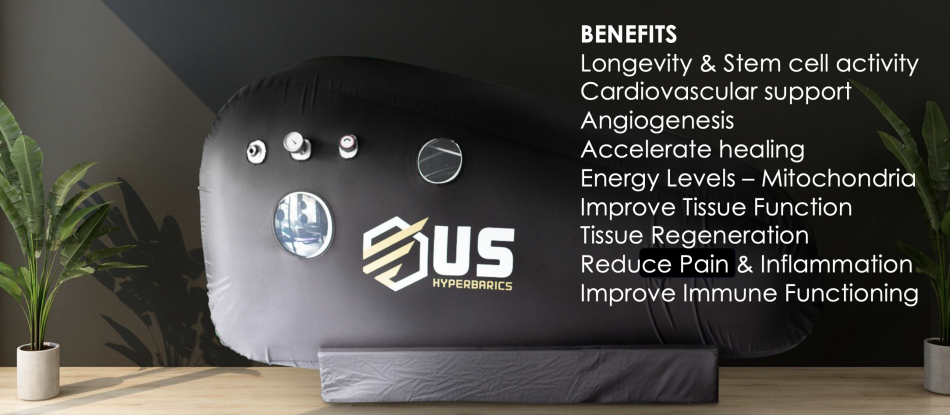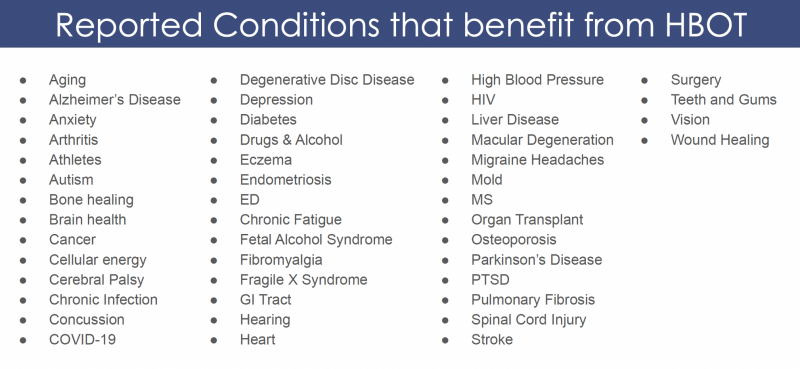Hyperbaric Oxygen - What is it & why use it?
Posted in Education, Hyperbaric Oxygen (HBOT), Longevity on Jul 06, 2023
Hello my friend. I have a treat I wish to share with you. I recently acquired a hyperbaric oxygen (HBOT) chamber and I’m enjoying its benefits and thought you should as well. If like most people, you have heard of hyperbaric oxygen but aren’t really sure what it is or how it works then let me offer some very cool insights.
What is HBOT?
There are 2 separate elements involved in hyperbaric oxygen therapy (HBOT). Giving the body a high oxygen concentration of 93% while at the same time applying greater atmospheric pressure. This combination drives oxygen into the tissue resulting in a super saturation of oxygen and this in turn drives a stronger and faster healing response.
Physiology - what is it doing?
There is a bi-physic effect that occurs. The initial phase is the oxygen saturation to drive a accelerated healing response. But as the body steps out of the high oxygen concentration the saturation begins to drop back to normal. This drop is misinterpreted by the body as a hypoxic situation. This is what results in the second phase reaction or hormetic effect whereby the body takes a defensive stance and drives mitochondrial biogenesis, angiogenesis, and stem cell activation. This is precisely the desired physiology that promotes a younger physiology and a healthier day to day existence. Here is a list of documented impacts from HBOT exposure:
• Stem cell activation and mobilization. See our webinar on “Stem Cells”.
• Angiogenesis - formation of new blood vessels, branching
• Mitochondrial biogenesis - forms new mitochondria to produce more energy
• Immune system balance results in less inflammation, less swelling, less pain
• Antioxidant systems are enhanced: glutathione increases, as free radical scavengers
• Senescent cells (old cells) are suppressed and telomere elongation occurs

Who benefits?
Because oxygen therapy has such a ubiquitous impact across the whole of our physiology, we see a very wide range of conditions that improve with HBOT therapy. Studies have been conducted on all of the following:

Is high pressure better than low pressure HBOT?
It might be easy to assume that more pressure creates more results but this is not what the studies have taught us thus far. In a study by Kendall et al. in 2013 (Different oxygen treatment pressures alter inflammatory gene expression in human endothelial cells) they compared the action of HBOT at 1.5 atmospheres to a 2.4 atmosphere setting. They demonstrated that low pressure HBOT actually engaged more genes involved in vascular health and reduction of inflammation than high pressure HBOT. This surprised the authors of the study. They concluded that low pressure HBOT would be more efficacious in vascular recovery and would healing.
The paper by Harch in 2013 explored this idea further and reported on the impact of low pressure HBOT on head trauma patients showing that low pressure HBOT consistently drove great results.
The Efati study in 2014 (How And Why Hyperbaric Oxygen Therapy Can Bring New Hope for Children Suffering From Cerebral Palsy--an Editorial Perspective) discussed the use of lower versus higher HBOT and as other authors demonstrated, lower pressures were not inferior to higher pressure treatments.
Risks or Dangers - Safety is key
High pressure HBOT where the atmospheric pressure is increased to 2 or 3 atmospheres can be beneficial, but it comes with a good amount of risk. The first challenge is that many people simply can’t tolerate that pressure comfortably as it hurts their ears. Secondly, high pressure tanks require the patient to lie flat and wear anti-static clothing to avoid friction that might cause a spark leading to combustion. Patients can not have any electronic items with them as again the risk for sparks. This leads to a very unsatisfactory experience.
Contrast this with low pressure HBOT at 1.3 to 1.5 atmospheres. No special clothing is required and the patient can lie or sit upright depending on their preference. They can operate a phone, iPad, laptop, or any other electrical device that is battery powered. The pressure on the ears is far more tolerable, even for children. There is no chance for sparks or combustion as the oxygen is 93%, not 100%. No risk of oxygen toxicity. Given its ease, there is little resistance to repeat therapies or longer applications.
How to engage
You know that I enjoy growing older but have no interest in aging. This is why I engage HBOT multiple times per week as an anti-aging strategy. I recommend 2 braod uses of the HBOT technology:
• ACUTE use – you have an acute injury or issue that needs more “intensive” care.
Ankle sprain, broken bone, skin wound, recent heart attack or stroke, rapidly advancing cognitive decline, uncontrolled pain, infection, etc.
This would require a 1 hour session 3 to 5 times per week for 2 weeks and then assess ongoing need. It may require a total of 20 to 40 sessions.
• CHRONIC or Preventive strategies – to improve general health
Consider doing a 1 hour session 2-3 times per week for just 2 weeks and assess the impact it had had for you. Then decide future needs.
General prevention – once per week or twice per month.
• Have Dr. Bianco or Dr. Huber help you decide best course of action and roll it into your overall health plan
Simply call the office and ask Shannon to set you up with a time. Cost for each session is discounted based on size of package purchased. One session is $100 but I wouldn't recommend this as it isn’t enough exposure to make a huge difference.
• Package of 10 sessions - $90/each - $900
• Package of 20 sessions - $80/each - $1,600
• Package of 40 sessions - $70/each - $2,800
You can bank these and use them at any pace you desire. Use them at greater frequency during times of higher stress and during heavy training periods. You decide what best suits you.
We look forward to your questions,
Dr. Gary Huber, Dr. Tony Bianco, Chelsea Dorsett and
the entire crew at Huber Personalized Medicine
